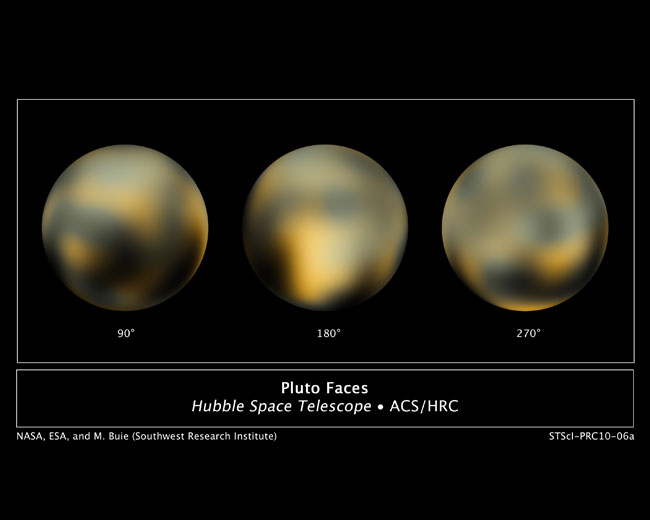Strange Spots on Pluto May be Tar and Frost

When scientists got an unprecedented up-close view of Plutofrom the Hubble telescope recently, they found mysterious bright and dark spotsmottling the dwarf planet's surface. Now researchers think they have a betterguess at what's causing those weird spots.
The Hubbleimages, released in February, revealed Pluto as a molasses-colored world onthe fringe of the solar system with surprising variations in brightness acrossits surface. Based on closer analysis, scientists say the darker spots mayrepresent parts of the ground covered in a tar of primordial organic compounds.
"We know there's methane on Pluto," said dwarfplanet expert Mike Brown of Caltech. "Here's what we think happens:Sunlight hits the methane and breaks it apart into its chemical components ??hydrocarbons.Over millions of years this process makes a dark reddish-brown oil or tar-likesubstance that sticks to the ground. These darker areas spread larger as theyabsorb more sunlight and cause additional frost to sublimate."
The bright spots, in turn, are thought to be related toareas covered in carbon monoxide frost.
These recent viewsof Pluto reveal a different picture from what astronomers observed in past images,partly because the dwarf planet's appearance is changing with the seasons. Butseasons are extremely long on Pluto. The reason: It takes the world 248Earth-years to make a full trip around the sun.
"Until the mid-1980s, Pluto's northern hemisphere wastilted away from the sun for over 100 years, accumulating a substantial amountof frost," said study leader Marc Buie of the Southwest Research Institute."Now the northern hemisphere is coming into sunlight and appears, as shownin the Hubble images, to have been growing brighter."
Right now, Pluto is a relatively balmy minus 385 degreesFahrenheit (minus 232 degrees Celsius), following its closest approachto the sun in the late 1980s. But Pluto is in for some colder times in thefuture.
Get the Space.com Newsletter
Breaking space news, the latest updates on rocket launches, skywatching events and more!
And when temperatures get frigid enough, scientists thinkthe gas in Pluto's wispy atmosphere will actually freeze and fall to theground.
"Now, Pluto is headed away from the sun again,"says Brown. "It will gradually get colder and colder and its atmospherewill refreeze to its surface. In fact, that should have already startedhappening, but apparently it has not. It's a mystery."
If Earth ever got cold enough for its atmosphere to freeze,it would create a layer 30 feet (9 meters) thick. Luckily, our planet is atropical paradise compared to Pluto.And Pluto's atmosphere is so thin, when it freezes it will make only a frostyfilm of nitrogen and methane.
The new Hubble views of Pluto are just the tip of theiceberg for scientists studying the frigid world. NASA's New Horizonsspacecraft is currently speeding toward Pluto on a decade-long trek across thesolar system.
NASA launched New Horizons in January 2006. It zoomed pastthe moon in 10 hours and swung around Jupiter a year later, making it NASA'sfastest spacecraft ever sent to another planet.
New Horizons is hitting a series of midpoint milestones onits trip to Pluto this year. The probe is due to fly by Pluto and its threemoons ? Charon, Nix and Hydra ? in July 2015.
- Gallery: Our New Solar System
- Pluto's Identity Crisis Hits Classrooms and Bookstores
- New Views of Pluto Reveal Weird Bright Spot
Join our Space Forums to keep talking space on the latest missions, night sky and more! And if you have a news tip, correction or comment, let us know at: community@space.com.

Clara Moskowitz is a science and space writer who joined the Space.com team in 2008 and served as Assistant Managing Editor from 2011 to 2013. Clara has a bachelor's degree in astronomy and physics from Wesleyan University, and a graduate certificate in science writing from the University of California, Santa Cruz. She covers everything from astronomy to human spaceflight and once aced a NASTAR suborbital spaceflight training program for space missions. Clara is currently Associate Editor of Scientific American. To see her latest project is, follow Clara on Twitter.









